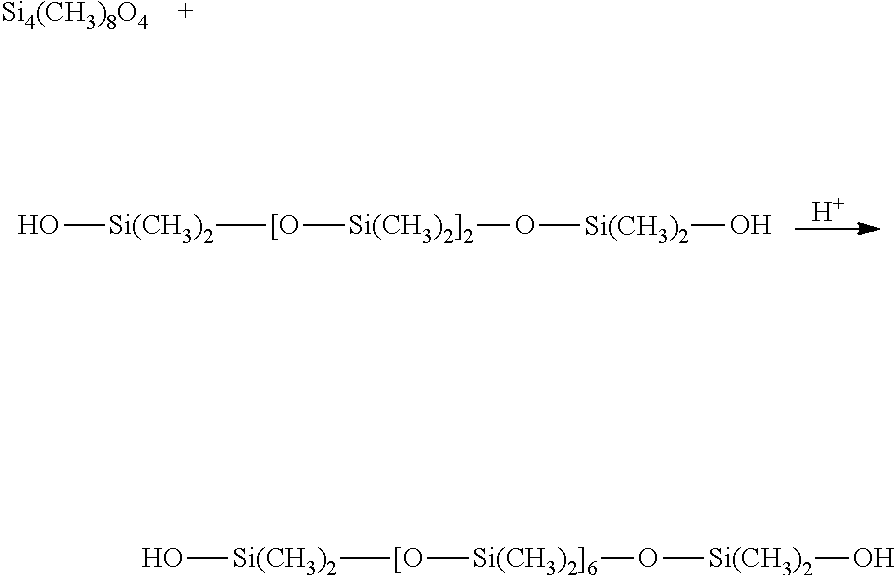Regenerative adsorption process for removal of silicon-containing contaminants from process gas using a neutral adsorbent media
a technology of neutral adsorption and process gas, which is applied in the direction of separation processes, gaseous fuels, fuels, etc., can solve the problems of reducing the useful life and reducing so as to reduce the regeneration time, reduce the useful life and reduce the capacity of the sorben
- Summary
- Abstract
- Description
- Claims
- Application Information
AI Technical Summary
Benefits of technology
Problems solved by technology
Method used
Image
Examples
example 1
[0040]The purpose of this example is to illustrate the effects of surface acidity and surface alkalinity on polymerization reactions related to D4 siloxane. Coconut shell carbon as 12×30 mesh granules were ground into less than 200 mesh powder. Surface acidification was performed by slurrying approximately 10 g of the carbon powder in 100 ml of a boiling HNO3 solution for 1 hour. The slurry was filtered, then washed with 250 ml DI water and dried at 110° C. for 1 hour. This treatment yields acidic oxygen sites on the carbon surface. This sample is referred to as “Acidic Carbon.”
[0041]Coconut shell carbon was neutralized by slurrying approximately 10 g in 100 ml DI water and titrating from a pH of 10.6 to a pH=7 using a dilute HNO3 solution. The resulting slurry was filtered, then dried at 110° C. for 1 hour. This treatment neutralizes basic oxygen sites associated with the coconut carbon. This sample is referred to as “Neutral Carbon.”
[0042]The alkalinity / acidity of the carbon sampl...
example 2
[0048]The purpose of this example is to illustrate the ability of a Neutral Surface Media to desorb siloxanes. 12×30 mesh coconut carbon was neutralized as described previously in Example 1. 14 cm3 of Neutral Surface Media granules were loaded into a 3 cm diameter test cell and exposed to 125 ppm D4 siloxane in humid air (5.5% H2O) at 140° F. and a residence time of 0.23 seconds. The surface area of the carbon granules was 1,650 m2 / g. The effluent concentration of siloxane was monitored continuously using a gas chromatograph throughout the duration of the run. The feed was terminated following 21 hours, at which time, the effluent concentration of D4 siloxane was consistent with that of the feed. The bed was then heated to 500° F. in 2 hours (rate=180° F. / hr) under flowing, humid air, with the final temperature maintained for an additional 18 hours. Nearly 90% of the adsorbed D4 siloxane was desorbed during regeneration of the bed, illustrating the effective removal of siloxane from...
example 4
[0050]A pilot scale temperature swing adsorption system (TSA) was constructed and installed at a landfill gas test site. The process consisted of two vessels each containing approximately 3.7 liters of adsorption media. The media consisted of neutralized activated carbon as 4 mm diameter extrudates (surface area=1,100 m2 / g). 1 g of media slurried in DI water yielded a pH value of 7.82. The TSA was operated with a nominal inlet temperature of 105° F. and a nominal bed regeneration temperature of 525° F. The adsorption time was varied between 8 and 14 hours. The regeneration step consisted of heating to 525° F. in 1 hour, maintaining this temperature for 5.5 hours, then cooling the bed to 105° F. in 3.5 hours. The feed flow rate was 3 Nft3 / min. Nft3 refers to normal cubic foot, which is defined as one ft3 of gas at 1 atmosphere pressure and 77° F. Product gas was used to purge the bed at a flow rate of 1 Nft3 / min. The process stream was comprised of nominally 10-15 ppm D4 siloxane and...
PUM
| Property | Measurement | Unit |
|---|---|---|
| temperature | aaaaa | aaaaa |
| temperature | aaaaa | aaaaa |
| temperature | aaaaa | aaaaa |
Abstract
Description
Claims
Application Information
 Login to View More
Login to View More - R&D
- Intellectual Property
- Life Sciences
- Materials
- Tech Scout
- Unparalleled Data Quality
- Higher Quality Content
- 60% Fewer Hallucinations
Browse by: Latest US Patents, China's latest patents, Technical Efficacy Thesaurus, Application Domain, Technology Topic, Popular Technical Reports.
© 2025 PatSnap. All rights reserved.Legal|Privacy policy|Modern Slavery Act Transparency Statement|Sitemap|About US| Contact US: help@patsnap.com


